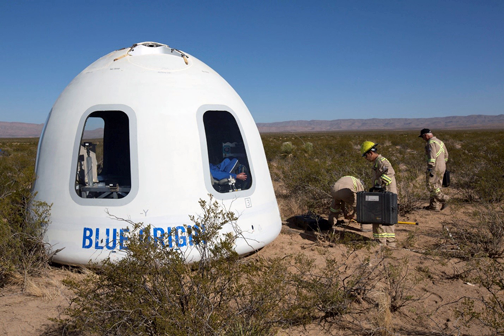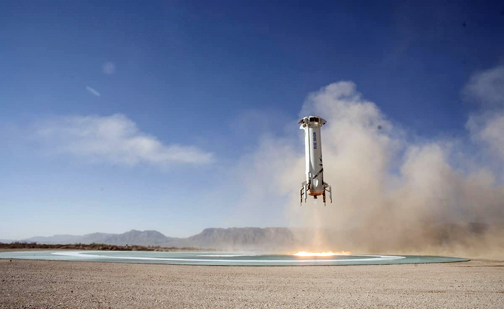On December 12, 2017, Blue Origin's New Shepard flew again for the seventh time — known as Mission 7 (M7), the flight featured the company's next-generation booster and the first flight of Crew Capsule 2.0.

Blue Origin's Crew Capsule 2.0 landed after the company's first successful commercial payload flight. Photo is courtesy of Blue Origin.
While the primary objective was to progress testing this new system for human spaceflight, the company also achieved an exciting milestone with suborbital research in space by sending 12 commercial, research and education payloads under full FAA license for the first time. Payloads flying on New Shepard were engaged in important science and research onboard the 11 minute flight to space and back. During this flight, Blue Origin customers get approximately three minutes in a high-quality microgravity environment, at an apogee around 100 kilometers, making New Shepard ideal for microgravity physics, gravitational biology, technology demonstrations, and educational programs.

Blue Origin's New Shepard Mission 7 Booster Landing on December. Photo is courtesy of Blue Origin.
The combination of high altitude and low-gravity exposure provides an environment for a wide range of payloads ranging from basic and applied microgravity sciences to Earth and space science. Each of these domains has the opportunity to engage users ranging from universities to corporations. The rapid timelines and low costs of flight are also increasingly attracting educators and students of all ages.
Below are a few highlights of investigations that were a part of the New Shepard M7 flight:
-
Zero-Gravity Glow Experiment (ZGGE)
Purdue University & Cumberland Elementary School (West Lafayette, Indiana) in partnership with Arete STEM
The Zero-Gravity Glow Experiment, or ZGGE for short, was inspired by a second grade classroom’s question: “Can fireflies light up in space?” The payload operates by mixing the appropriate chemicals during the weightless coast period of the vehicle’s mission and observing the response with a miniature video camera.
-
DCS Montessori Middle School (Castle Pines, Colorado)
In Partnership with DreamUp
This payload was a collaboration across nearly 500 K-8 students and consisted of two parts. The first included an Arduino Nano microcontroller with a sensor package, designed and programed by the students to learn more about the environment inside the Crew Capsule. The second part contained a school-wide art project that all DCS Montessori students participated in. Upon landing, the data from the experiment will be analyzed and the art will be returned to the students and shared with the community.
-
Cell Research Experiment in Microgravity (CRExIM)
Embry-Riddle University-Daytona Beach, University of Texas Health Science Center at San Antonio & Medical University of South Carolina (Daytona Beach, Florida) in partnership with Arete STEM
The CRExIM (Cell Research Experiment In Microgravity) NanoLab was a multidisciplinary effort between students and faculty in Embry-Riddle’s Spaceflight Operations degree program and Aerospace and Mechanical Engineering departments, who partnered with other teams from the University of Texas Health Science Center at San Antonio and the Medical University of South Carolina. The experiment studied how microgravity impacts the cellular processes of T-cells, which develop from stem cells in the bone marrow and are key to immune system function.
-
Expression of Genes in Tumor Growth
Embry-Riddle University-Daytona Beach, Grand Canyon University & Thermo Fisher Scientific (Daytona Beach, Florida) in partnership with Arete STEM
This payload focused on studying the effect of microgravity exposure on the expression of genes that play a role in tumor growth. Two modified flasks were seeded with osteosarcoma cells. Syringes containing RNAlater for cell fixation were attached to each flask and their contents were deployed just before the onset of microgravity (in the case of the experimental control flask) and just after its completion (in the case of the experimental test flask). Now that the mission is complete, the samples will be analyzed via reverse transcription-polymerase chain reaction (RT-PCR) to determine how the expression of the genes has changed.
-
JANUS Research Platform
Johns Hopkins University-Applied Physics Laboratory (Baltimore, Maryland)
The JANUS integration and monitoring platform, about the size of a car battery, provides researchers with a look at suborbital flight conditions. While this flight deployed JANUS in the shirtsleeve environment of the New Shepard cabin, future iterations will also look at the environment outside the vehicle.
-
Evolved Medical Microgravity Suction Device
Orbital Medicine (Richmond, Virginia) with Purdue University (West Lafayette, Indiana), with funding from NASA’s Flight Opportunities Program
The Evolved Medical Microgravity Suction Device could assist in treatment of a collapsed lung where air and blood enter the pleural cavity. The payload — which included the device along with a hemothorax simulator — was constructed in collaboration with the Purdue University School of Aeronautics and Astronautics. The device is able to collect blood in microgravity, and still allows for the suction to continuously inflate the lung and allow it to heal. The payload marked Blue Origin’s first flight under NASA’s Flight Opportunities program.
Blue Origin's frequent flight schedule will enable the launch of experiments multiple times to iterate on findings, improve statistics, or rapidly collect data. As human flights begin, customers will also be able to fly with their payloads for hands-on experimentation.

